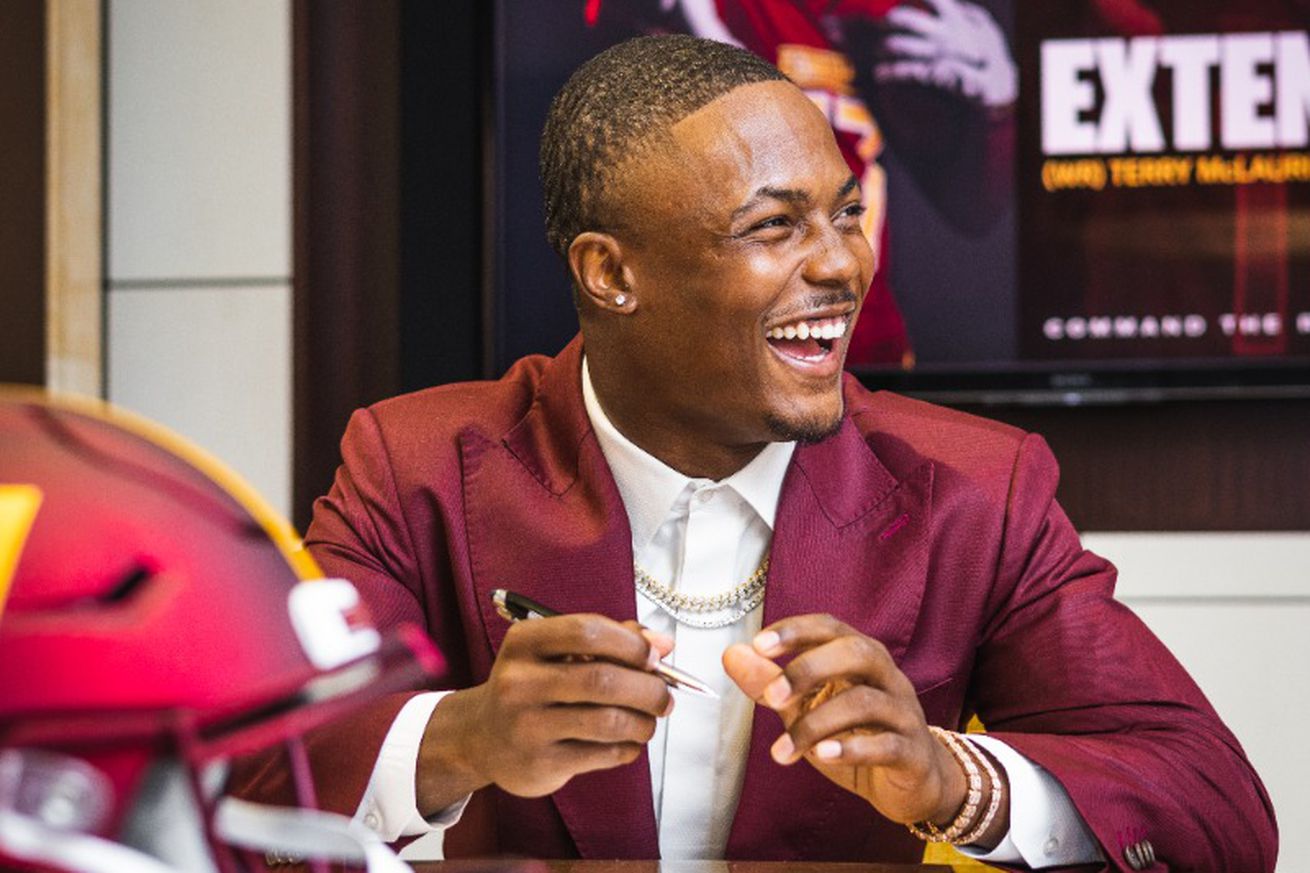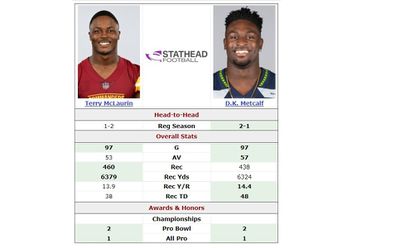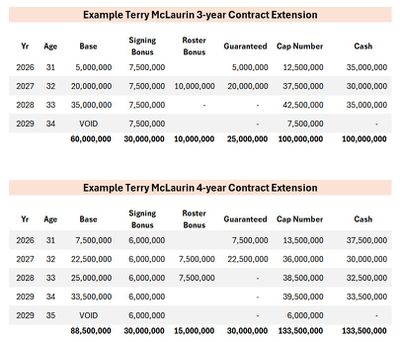
With veterans due at Washington’s training camp on July 22nd, the clock is ticking toward an important deadline
Terry McLaurin’s extension
The ground that will be covered in this article has been well-trodden this offseason; so much so, that it feels like every interested fan knows the issues and the answers, which appear to many Commanders fans to be pretty straightforward and easy to resolve. If that were true, though, things would already have been resolved and Terry McLaurin’s contract extension would be a done deal. So far, it’s not.
So, today, while there’s no new news to report, we’re going to review the issues that may be holding Terry and the Commanders apart, and discuss what a resolution may look like.
Mutual interest in a deal
First of all, there is no dispute about whether McLaurin has earned a contract extension or whether the Commanders want to give it to him. Back in April, Adam Peters, Washington’s GM, publicly stated the team’s desire to make Terry McLaurin a “Commander for a long time”. Peters described the discussions with Terry’s agent at that point as “really positive”. He emphasized McLaurin’s value to the team and community as both a player and a leader, acknowledging his career-best 13 touchdowns in 2024. Despite McLaurin having one year remaining on his current deal, the team aims to secure him on a long-term contract.
So, what is holding the team back from getting this deal done?
We’ve seen rumors about the front office relying on the Mike Evans contract to low-ball Terry, alongside contrasting claims that McLaurin’s agent is being unreasonable in his demands and dealings, and even speculation that the two sides can’t agree on the length of the deal.
To be honest, outside of the team executives, Terry’s agent, and Terry himself along with his close circle of family and friends, nobody seems to know for sure. One of the hallmarks of the Commanders franchise since the arrival of Adam Peters is that information doesn’t seem to leak out — and that’s a good thing, if a bit frustrating for fans hoping for news.
Back in April, when he was discussing the extension situation, Peters said, “Just like any talks, those (details) will stay in the house”, and they have.
Still, there are a limited number of key issues that are likely to keep a willing front office and one of its star players from reaching agreement for several months. The usual suspects are:
- Contract value
- Contract length
- Guaranteed money — amount and timing
Without having a spy inside the Washington front office or the office of Terry’s agent, it seems as if any discussion of these points is speculation, and I definitely don’t have such a spy. But NFL contracts follow conventions and precedents, so it’s at least possible to discuss these key issues in a logical framework and make some educated observations.
Contract value
There are a number of ways to assess the ‘right’ value of a player’s contract. In this section, we’ll discuss three of them: comparable contracts, salary cap growth, and franchise tag values.
Comparable contracts
One way to assess the contract value issue is to look at the list of wide receiver salaries on a site like Over the Cap, and find the place where the player seems to fit in. In the middle of a season, this is often the most expedient method, but at this point in the offseason, the most relevant contracts are the extensions for top-tier wide receivers signed last year and this year. During this 2025 offseason, as most NFL fans are aware, the WR market was re-set.
Here are some player contracts that seem most relevant to Terry’s situation:
- Tyreek Hill: ~$30M+ APY at age 30
- DK Metcalf: ~$33M APY at age 27 with $60M guaranteed
- CeeDee Lamb: $34m APY
- A.J. Brown: $32M APY
- Brandon Aiyuk: $30M APY
- Tee Higgins: $28.75M APY (benchmark No. 2 WR)
Hill is the only player on the list as old as McLaurin (30 in September) at the time of signing, but he signed his deal a year ago.
Metcalf was drafted in the same year as McLaurin and has had comparable production.

The outliers — which are not included in the list of comparables above — seem to be Ja’Marr Chase on the high side and Mike Evans on the low side. Chase, the Bengals receiver who is generally acclaimed as the best in the NFL, signed a 4-year deal worth $40.25m per season in March. Evans, a 32-yr-old 11-year veteran who has long been one of the NFL’s best, signed a modest 2-year extension prior to the ‘24 season that pays him only about $22m per season.
While there have been rumors that the Commanders have relied on the Mike Evans contract as the most relevant due to his age, there seems general consensus in the media, at least, that Brandon Aiyuk’s $30m APY should set the floor for the annual value of McLaurin’s extension, while Metcalf’s $33m per year seems to create an intuitive target for McLaurin’s deal. At the high end, Justin Jefferson’s $35m per year extension signed in 2024 would seem to set the likely ceiling for any negotiation.
Spotrac estimates McLaurin’s annual contract value at $31.1m .
In a recent poll of Hogs Haven readers, 63% said that Terry’s contract value would have an APY of at least $32m.
CBS Sports offered this summary for the comparable contract comparison:
One way to try to help resolve the stalemate between McLaurin and the Commanders could be to look at the contracts of the six wide receivers named first- or second-team All-Pro last season: Chase, Jefferson, [and] Amon-Ra St. Brown, were on the first team.
A.J. Brown joined Lamb and McLaurin as the second-team wide receivers.
Collectively, these…wide receivers are signed to extensions with $722.61 million of new money for 22 new contract years to average $32,845,909 per year. The oldest of these wide receivers at signing, excluding McLaurin, was Brown. He turned 27 a couple of months after he got his deal. The other four were either 25 or close to being 25 when they signed.
Alternate valuation methods
Salary cap growth
This method was included in a great analysis of the McLaurin extension dynamics by former NFL agent Joel Corry published this week:
The salary cap has increased by 34.1% since McLaurin signed in 2022. His deal is a little less than $31.125 million per year when factoring in salary cap growth.
Looking at franchise tag values
Washington fans became intimately familiar with the use of franchise tag values to calculate contract extensions back in the Kirk Cousins days. Basically, if you calculate the cost of tagging Terry in 2026 & 2027, it creates a baseline for the value of the new contract.
Per CBS Sports, it would cost between $30.2m and $30.45m to franchise tag McLaurin for the ‘26 season. A second franchise tag in ‘27 would cost in the neighborhood of $36.4m. This means that it would cost Washington roughly $67m to franchise tag McLaurin for 2 years, setting a base value of around $33.3m per year for any negotiations.
Washington fans know from experience that relying on franchise tags to keep a player on the team is not ideal, but, while we don’t really want to contemplate using franchise tags on Terry, this method of valuation is based on pretty solid numbers, defined in the CBA, which could prove useful for setting a starting point for the discussion of contract value.
Contract length and guarantees
In the NFL, contract length is often something of a mirage since teams can cut players at any time.
In most NFL contracts, the final year or two of a player contract has no guaranteed money. If the player’s performance is exceeding the value of his contract, the team keeps him around on what is, in effect, a team option year. If the team does not believe he is worth the money, then the player can be traded or released, as we saw this offseason with players like Jonathan Allen, Deebo Samuel and Laremy Tunsil.
Thus, in the practical world of the NFL, a 3-year contract is usually a 2-year deal with a one-year team option, while a 5-year contract is usually a 3-year deal with two team option years.
When McLaurin signed his first contract extension in 2022 — a 3-year deal at age 27 — I commented in an article here on Hogs Haven:
The length of the extension means that Terry McLaurin will have another chance at free agency in his age 31 year, meaning that he will probably still be able to garner interest and earn one more strong payday before his career starts to wind down.
Now, in 2025, the time has arrived for McLaurin to cash in. Terry’s current situation is completely different from 2022 when he could expect another chance at big money in the future. Whatever extension Terry signs next is likely to be the biggest payday of his career and the last bite at the apple before his perceived value fades as he gets further and further past his 30th birthday.
McLaurin’s interests are probably best served by either a very short (2-year) high-dollar, fully guaranteed contract, or — more likely — a longer-term deal of 3 or 4 years that offers some income and roster security beyond the ‘27 season. He will be 33 years old in 2028 and probably no longer able to command top-dollar in the NFL.
The Commanders front office will be happy, I would think, to give Terry a longer contract length, but the team is likely to balk at any kind of significant guarantees in the 2028 season or beyond.
The issue of long-term guarantees would seem to be the most likely to keep the two sides apart during months of negotiation.
Complex guarantee structures
McLaurin’s current contract contains some complex guarantee structures.
- Terry McLaurin had a $12.5m salary guarantee for 2024 based on being on the roster on March 20 of 2023. This meant that, to avoid triggering Terry’s guarantee 2024 guarantee, the Commanders would have needed to release Terry before the start of the 2023 league year.
- The balance of his 2024 salary (another $6m) was guaranteed when he was on the roster on the 3rd day of the ‘24 league year (in March ‘24).
This may seem strange, as it is almost unthinkable that the team would have cut Terry in time to avoid triggering the first guarantee of $12.5m, but it was simply a cash flow management tool, and one which was designed to give Terry comfort that this money would be paid to him.
Under NFL rules, guaranteed money needs to be deposited to an escrow fund in cash by the owner on the day it is guaranteed. If Terry’s ‘24 money had been guaranteed at signing, then the $18.5m would have had to have been deposited when he signed the contract in 2022.
By using the roster triggers instead, Terry was virtually assured of getting at least $12.5m of the ‘24 money, but the team was able to wait until until 20 March 2023 to deposit $12.5m, and another year after that to deposit the remaining $6m.
This is a common feature of NFL contracts, and one that we may see in Terry’s next extension, which Commanders fans all hope will be signed by July 22nd, the date on which Terry and other veterans are required to report to training camp.
So, what does it all mean?
This contract extension is vitally important to Terry McLaurin. It is the last great opportunity to secure his and his family’s financial future. Getting the most advantageous deal possible should be of paramount importance to Terry and his agent.
The Commanders front office is keen to reward a player who has been the very definition of Washington football since the day he was drafted in 2019.
In addition, the Commanders front office is certainly aware of how much McLaurin means to the fan base. There would be a lot of outrage from Washington fans if Terry’s extension failed to be consummated. It seems reasonable to assume that Terry’s agent is equally aware of the public pressure to get a deal done, and that he is likely using that leverage in the negotiation.
In that sense, this contract is about more than simply finding the right value and duration. It revolves around rewarding players who do things right on the field, in the meeting rooms and locker room, and in the community. What happens with this contract extension makes a statement about what the Washington Commanders believe in.
At the same time, it would be irresponsible for Adam Peters to hand a blank check to Terry’s agent and tell him to fill in an amount. Negotiating big contracts has long-term effects and needs to be dealt with in a serious and professional manner.
The value of Terry’s extension can be argued, but, in my opinion, only within fairly narrow constraints. The three different valuation methods discussed above gave results that ranged between $31.1m and $33.3m per year. I’ll be surprised if McLaurin and the team can’t find some common ground in the range of contract values that have been discussed for months in the sports media. If they can’t find agreement on the contract value at some dollar value in this neighborhood, then it would raise questions about whether one or both of the two parties is serious about reaching agreement.
As discussed above, contract length is a flexible concept in the NFL. A 3- or 4-year deal seems the most likely outcome.
What matters most, and what is likely to be the most contentious issue in this negotiation, is the guaranteed money. At 30 years old, McLaurin should be looking for security while the Commanders front office will be looking for mitigation of risk and management of cash flow.
I expect that the extension, when it is finally announced and signed, will be a 3-year, $100m or 4-year, $133.5m contract — or something in that neighborhood.
The key questions to be answered will revolve around the amount and timing of the guarantees. I would expect the Commanders to be willing to offer strong guarantees for the ‘26 and ‘27 seasons, but resistant to guaranteeing money in ‘28 or beyond, while Terry’s agent is likely to be demanding long-term income security for his client. I would see any guarantees for the ‘28 season to be a ‘win’ for McLaurin, and any such guarantees not to be guaranteed at signing, but to be triggered in a manner similar to his current contract.
In the end, I expect Terry’s contract extension to be built on a model similar to DK Metcalf’s 4-year, $132m deal, and to look something like the models below, which both come in slightly better than Metcalf’s deal, which would represent a ‘win’ for McLaurin while representing a reasonable outcome for a Commanders front office eager to get the team’s popular star receiver to training camp on time.

